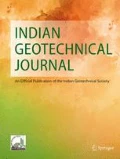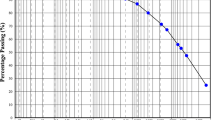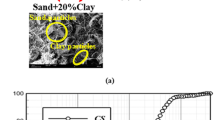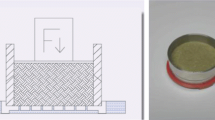Abstract
Chemical stabilization is one of the most successful among the techniques devised for reducing the volumetric changes of expansive soils. Lime and cement, fly ash and pond ash, calcium chloride and calcium silicate are some of the additives used for stabilizing expansive soils. This paper presents the influence of ground granulated blast furnace slag (GGBS) on swell-compressibility characteristics of a remoulded expansive clay passing 4.75 mm sieve. FSI, rate and amount of heave, swell potential (S%), swelling pressure (ps), coefficient of compressibility (av), compression index (Cc) and linear shrinkage (LS) of GGBS–clay blends were studied varying the GGBS content such as 0, 4, 8 and 12% by dry weight of the soil. It was observed that swellability and compressibility of the expansive clay decreased with increasing GGBS content. At 12% GGBS, the amount of heave was the lowest. The paper compares the effect of 12% GGBS on clay lumps passing 4.75 mm sieve and clay powder passing 425 µm sieve. While swell potential (S%) was found to be more for clay powder than for clay lumps at 12% GGBS, swelling pressure was higher for clay lumps than for clay powder. The paper also presents FSI data on clay–lime blends with varying lime content. As 4% lime resulted in the highest reduction of FSI, two more series of swell-consolidation tests and FSI tests were conducted on GGBS–clay blends to which 4% lime was added. Interesting phenomena were observed which the paper discusses in detail.












Similar content being viewed by others
References
Chen FH (1988) Foundations on expansive soils. Elsevier, Amsterdam
Nelson DJ, Miller JD (1992) Expansive soils: problems and practice in foundation and pavement engineering. Wiley, New York
Lu N, Lykos W (2004) Unsaturated soil mechanics. Wiley, New York
Gourley CS, Newill D, Schreiner HD (1993) Expansive soils: TRL’s research strategy. In: Proceedings of the 1st international symposium on engineering characteristics of arid soils, London
Satyanarayana B (1966) Swelling pressure and related mechanical properties of black cotton soils. Ph.D Thesis, I.I.Sc., Bangalore
Ranganatham BV, Sathyanarayana B (1965) A rational method of predicting swelling potential for compacted expansive clays. In: Proceedings of the 6th international conferrence on soils mechanics and foundation engineering, Canada, vol 1, pp 92–96
Katti RK (1978) Search for solutions to problems in black cotton soils. First I.G.S annual lecture, Indian Geotech. Society at I.I.T., Delhi
Sharma D, Jain MP, Prakash C (1978) Handbook on underreamed and bored compaction pile foundations. Central Building Research Institute, Roorkee
Phanikumar BR (1997) A study of swelling characteristics of and granular pile-anchor (GPAF) foundation system in expansive soils. PhD thesis. JN Technological University, Hyderabad, India
Phanikumar BR, Sharma RS, Rao AS, Madhav MR (2004) Granular pile-anchor foundation (GPAF) system for improving the engineering behavior of expansive clay beds. Geotech Test J Am Soc Test Mater 27(3):279–287
Phanikumar BR (2006) Expansive Soils: problems and remedies. In: Invited lecture, conference on corrective engineering practices in troublesome soils (CONCEPTS), Kakinada, pp 77–82
Cokca E (2001) Use of class C fly ash for the stabilization of an expansive soil. J Geotech Geoenviron Eng 127(7):568–573
Phanikumar BR, Sharma RS (2004) Effect of fly ash on engineering properties of expansive soils. ASCE J Geotech Geoenviron Eng 130(7):764–767
Phanikumar BR, Sharma RS (2007) Volume change behavior of fly ash-stabilized clays. J Mater Civ Eng 19:67–74
Phanikumar BR (2009) Effect of lime and fly ash on swell, consolidation and shear strength characteristics of expansive clays—a comparative study. Geomech Geoeng Int J 4(2):175–181
Phanikumar BR, Mani Anand J, Sathiyasheelan S, Reddy PR (2009) Fly ash columns (FAC) as an innovative foundation technique for expansive clay beds. Geomech Geoeng Int J 4(3):183–188
Phanikumar BR, Sastry MVBR (2001) Stabilizing swelling subgrades with calcium chloride. In: Highway research bulletin, vol 65, Journal of Indian Roads Congress, pp 77–82
Ramanamurthy V, Harikrishna P (2006) Stabilisation of expansive clay bed using calcium chloride stabilization. Ground Improv 10(9):39–46
Cokca E (1999) Effect of fly ash on swell pressure of an expansive soil. In: Electronic Journal of Geotechnical Engineering, vol 4
Kumar A, Walia BS, Bajaj A (2007) Influence of fly ash, lime and polyester fibers on compaction and strength properties of expansive soil. J Mater Civ Eng 19(3):242–248
Puppala AJ (2001) Fibre and fly ash stabilization methods to treat soft expansive soils. Geotech Spec Publ 112:136–145
Yadu L, Tripathi RK (2013) Effects of granulated blast furnace slag in the engineering behaviour of stabilized soft soil. Procedia Eng 51:125–131
Higgins DD (2005) Soil stabilization with GGBS. UK Cementitious Slag Makers Association (CMSA), Oxted
Gupta S, Seehra SS (1989) Studies on lime-granulated blast furnace slag as an alternative binder to cement. Highw Res Board Bull 38:81–97
Akinmusuru JO (1991) Potential beneficial uses of steel slag wastes for civil engineering purposes. Resour Conserv Recycl 5:73–80
Obuzor GN, Kinuthia JM, Robinson RB (2012) Soil stabilization with lime-activated GGBS—a mitigation to flooding effects on road structural layers/embankments constructed on floodplains. Eng Geol 151:112–119
Wild S, Kinuthia JM, Robinson RB, Humphreys I (1996) Effects of ground granulated blast furnace slag (GGBS) on the strength and swelling properties of lime-stabilised kaolinite in the presence of sulphates. Clay Miner 31:423–433
Holtz WG, Gibbs HJ (1956) Engineering properties of expansive clays. Trans ASCE 121:641–677
Yi Y, Gu L, Liu S (2015) Microstructural and mechanical properties of marine soft clay stabilized by lime-activated ground granulated blast furnace slag. Appl Clay Sci 103:71–76
Sharma A, Sivapullaiah PV (2012) Improvement of strength of expansive soil with waste granulated blast furnace slag, GeoCongress 2012, Oakland, California, USA. https://doi.org/10.1061/9780784412121.402
Phanikumar BR, Sreedharan Rishi, Aniruddh C (2015) Swell-compressibility characteristics of lime-blended and cement-blended expansive clays—a comparative study. Geomech Geoeng Int J 10(2):153–162
Author information
Authors and Affiliations
Corresponding author
Rights and permissions
About this article
Cite this article
Phanikumar, B.R., Nagaraju, T.V. Swell and Compressibility of GGBS–Clay Mixes in Lumps and Powders: Effect of 4% Lime. Indian Geotech J 49, 161–169 (2019). https://doi.org/10.1007/s40098-018-0302-x
Received:
Accepted:
Published:
Issue Date:
DOI: https://doi.org/10.1007/s40098-018-0302-x




